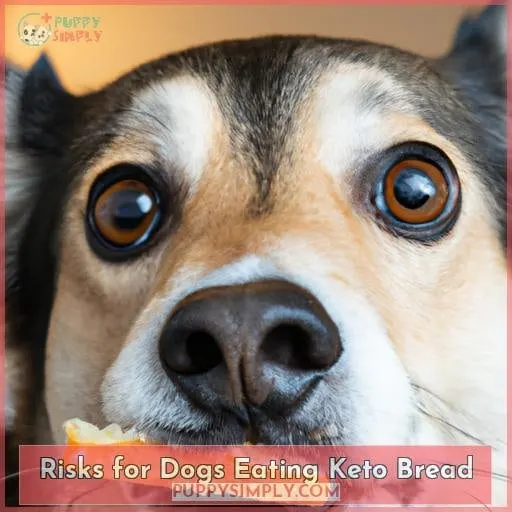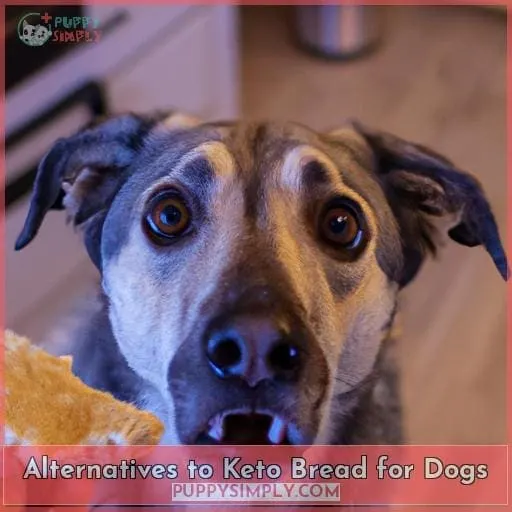This site is supported by our readers. We may earn a commission, at no cost to you, if you purchase through links.
We all love our furry friends and want to make sure they are happy, healthy, and well-fed.
In this article we’ll explore the ingredients in keto bread as well as potential risks associated with feeding your pup these treats. We’ll also look into some healthier alternatives that both you and your pooch can enjoy together.
So let’s get started on discovering if a dog really should be eating Keto Bread or not!
Table Of Contents
Ingredients in Keto Bread
 We’re here to discuss the ingredients in keto bread and whether or not it’s safe for dogs. Xylitol, macadamia nuts, chocolate and avocado are some of the potential hazards that can be found in keto bread recipes.
We’re here to discuss the ingredients in keto bread and whether or not it’s safe for dogs. Xylitol, macadamia nuts, chocolate and avocado are some of the potential hazards that can be found in keto bread recipes.
All of these items can cause side effects ranging from digestive issues to seizures if they are consumed by dogs, so caution should always be taken when feeding a dog any food containing them.
Xylitol
We need to be aware of the potential danger that xylitol poses, such as insulin spikes and liver damage – a real sweet nightmare for our furry friends! Xylitol is a sugar substitute often found in keto diets and it can cause an insulin spike in dogs.
Erythritol is another sugar substitute typically found in keto diets but with no effect on the release of insulin in people, making it safer than using xylitol. By monitoring carbohydrate intake and weight management while following a Keto diet, we can also minimize any allergy effects from ingredients like xylitol, which may pose risks when ingested by pets.
With this knowledge at hand, we have a better insight into how to keep our beloved animals safe from harm when implementing these types of dietary changes.
Macadamia Nuts
As Keto dieters, let’s watch out for macadamia nuts as they can cause tremors, fever, and temporary loss of use of back legs in our furry friends. Macadamia nuts are popular snacks in the keto diet. However, raw meat diets, gluten-free treats, and vegan options should also be taken into account to ensure your pet is not allergic or intolerant.
We must remember that these nut allergies can lead to pancreatitis and intestinal obstruction if ingested by dogs.
To keep them safe from harm, we should always double-check labels before purchasing anything with this ingredient included; better yet, opt for other alternatives such as Erythritol, which has no effect on insulin release, unlike Xylitol found commonly used within sugar-free products – fatal to dogs even with small amounts consumed!
All these precautions will help us provide the best nutrition plan tailored specifically towards your pet’s needs while ensuring their safety at all times.
Chocolate
To ensure our beloved companions’ safety, we must be mindful of the dark chocolate lurking in keto-friendly snacks and treats – it can be more dangerous to them than milk chocolate! While vegan substitutes such as carob chips are a safer option for pets, coconut flour or almond butter make great alternatives when baking up some tasty keto treats.
If you’re going to use dark chocolate in your recipes, make sure it’s sugar-free and doesn’t contain any xylitol which can have fatal consequences for dogs. It’s also important that all ingredients used are safe for cats and dogs – avocado pits should always be kept out of reach as they can cause digestive obstruction if ingested by felines or canine friends.
With these precautions taken into account when cooking up a storm with delicious keto breads, macadamia nuts should still remain off-limits due to their potential risks: tremors, fever, and temporary loss of use of back legs may occur if eaten by pets; pancreatitis may also occur from high-fat content while bones could lead to digestive issues.
To keep your pet happy (and healthy), it’s best avoided altogether!
Avocado
We must be mindful of avocados, as their pits can cause digestive obstruction in both cats and dogs if ingested. When using keto bread recipes that include avocado, it’s important to use the flesh only and not the pit or skin.
Keto dieters should also watch out for other potential pet hazards when baking with ingredients like raw eggs, coconut flour, almond milk, coconut oil, and coconut cream. Macadamia nuts are a popular snack on keto diets, but they can have deleterious effects on pets such as tremors, fever, and temporary loss of use of back legs in dogs.
Risks for Dogs Eating Keto Bread

High-fat content in keto diets can increase the risk of pancreatitis even more so in overweight or obese pets while bones from certain types of fish may cause a blockage if not properly cooked.
Pancreatitis
We should be aware that high-fat content in keto diets may increase the risk of pancreatitis, particularly for overweight and obese pets. This is a condition which can be more debilitating, dangerous, and expensive to treat.
The cause of pancreatitis is linked to a nutrient imbalance between carbohydrates vs protein or eggs vs dairy found in grain-free diets, as well as deficiencies created by low-carbohydrate/high-fat (keto) eating plans.
Moreover, when comparing digestion abilities amongst species, it appears that carbohydrate digestion is far less efficient than proteins or fats. This could lead to nutritional problems like digestive obstruction if not properly monitored with these types of dietary changes.
Therefore, special care must be taken when introducing any type of diet modification in order to prevent potential complications from arising due to an unbalanced nutrient consumption.
Transitioning into the next subtopic about ‘Digestive Obstruction’, we must consider how certain foods can create blockages within our pet’s gastrointestinal tract if they are consumed without cautionary measures being taken first.
Digestive Obstruction
Taking into consideration the potential for unbalanced nutrient consumption, we must be mindful of which foods might pose a risk of digestive obstruction when introducing any type of dietary change.
Keto bread is no exception; ingestion can lead to an upset stomach or even more severe gastrointestinal issues such as vomiting and diarrhea.
Pet nutrition experts advise pet owners to pay attention to their animals’ reactions and consult with a veterinarian if symptoms persist.
It’s especially important that those pets who are overweight or obese take extra precautions due to increased risks associated with higher carbohydrates intake than normal kibble safety standards suggest for them.
Additionally, it’s essential that pet owners monitor food allergies symptoms in case keto bread has gluten-based ingredients like wheat flour, rye flour etc., since these may trigger allergic responses in some sensitive dogs leading also towards GI distress complications down the line if left unchecked.
Xylitol Poisoning
We must be aware of hidden dangers such as xylitol poisoning, which can quickly turn a seemingly innocent snack into an unanticipated and potentially deadly treat.
Xylitol is a sugar alcohol found in many keto diet products that is extremely dangerous to dogs even if ingested in small amounts. It causes a rapid spike in insulin levels resulting in seizures, liver failure, or other life threatening medical issues for pets.
Not only should pet owners avoid feeding their dog any type of product containing xylitol but also make sure to check the ingredients list on all homemade treats made with free range diets or grain-free nutrition options before serving them up as snacks.
Natural remedies and pet supplements may also contain this sweetener so it’s important to be diligent when selecting items for your furry friend’s health needs too! To ensure maximum safety while still providing optimal nutrition, it’s best to consult your veterinarian about what foods are suitable for your pup during their transition onto the keto diet.
With careful consideration and planning, we can keep our four-legged friends safe from harm while still enjoying delicious meals together! Moving forward, let’s look at how digestive obstruction might occur when feeding dogs bread on keto diets.
Alternatives to Keto Bread for Dogs

Brown rice bread is also an ideal choice because it’s low-fat yet still provides lots of energy from the grains within it.
Sweet Potato Bread
Let’s explore a safer and healthier alternative to keto bread for our furry friends – sweet potato bread! Sweet potatoes are an excellent source of carbohydrates that provide essential vitamins and minerals such as Vitamin A, Vitamin C, Iron & Calcium.
Not only is it more nutritious than many grains used in other recipes, but its natural sweetness allows us to create delicious treats without the need for added sugar.
Here are five items you’ll need when making this type of dog-friendly treat:
- Raw feeding ingredient(s) like ground beef or chicken with bone meal
- Rice flour
- Coconut flour
- Almond flour
- Gluten-free products
All these ingredients can be combined to make an irresistibly tasty sweet potato loaf your pet won’t be able to resist! The great thing about this recipe is that it doesn’t have any unhealthy fats or hidden sugars like some other types of human snacks might contain.
Plus, all these ingredients can easily be sourced from local health food stores, making creating homemade treats even easier on both time and budget constraints.
Let’s take a look at another popular option for dogs – oatmeal bread…
Oatmeal Bread
We’re now exploring a healthier and tastier option for our four-legged friends – oatmeal bread! Oatmeal bread is low in carbohydrate content, making it perfect for dogs on a keto diet or those that are carb cycling.
Not only does this type of bread provide health benefits to our furry companions, but it also tastes great! For those who are gluten-free or have allergies, oatmeal can be used as an alternative grain when baking.
Baking with oats allows you to create delicious treats while still providing fiber and essential vitamins and minerals without the high carbohydrates found in traditional wheat flour products.
The amazing thing about baking with oats is that not only will your pup love eating them due to their scrumptious taste; they will also get all the necessary nutrients from its natural ingredients – no artificial sweeteners here either!
With fewer carbs than other types of flours available on the market today, there’s no doubt why so many pet owners opt for using oats when creating doggy snacks at home.
It’s clear why everyone loves oat-based goodies: they make meals enjoyable yet still beneficial for one’s health – both human and canine alike.
Brown Rice Bread
We’re now exploring another delicious and nutritious option for our canine friends – brown rice bread!
This type of bread, made from whole grain brown rice flour, is a great alternative to traditional wheat-based or keto-style breads. Not only does it provide the same nutritional benefits as other types of grains, but it also has a lower glycemic index than most carbohydrates.
It’s an excellent choice for those dogs who are sensitive to gluten or have allergies since its carbohydrate content is low and it contains no allergen ingredients such as eggs, dairy products, corn syrup solids, etc.
What’s more, baking your own rice flour dog treats at home can be easy with the right recipe and some helpful tips! For example, using sticky wetting agents like applesauce instead of oil can ensure that your pup gets the optimal texture in their treat without adding unnecessary fat content – plus they won’t even notice any difference in taste!
With these suggestions, you’ll soon be able to whip up yummy concoctions suitable for even picky eaters while still keeping them healthy too.
Frequently Asked Questions (FAQs)
What are the possible health benefits of feeding my dog keto bread?
We know that low-carb diets can be beneficial for dogs, especially when it comes to portion control and dietary fats. Keto bread is a great option for pet owners looking to provide their pup with alternative carbohydrate sources without the use of sugar substitutes.
Not only does this form of bread offer your dog an array of nutritious ingredients like eggs, cheese, and coconut flour, but it also provides them with health benefits such as improved digestion, balanced blood glucose levels, and increased energy levels.
With all these advantages in mind, keto bread is definitely worth considering if you’re wanting to give your furry friend something special!
Is it safe for dogs with certain health conditions to eat keto bread?
We know that low-carb diets can be beneficial for dogs in certain health conditions, but is it safe to feed them keto bread?
Many vets recommend a moderate carb intake for most pets, and diet variations should always be discussed with your vet before making changes. Keto diets are high fat and low carbohydrate plans that require careful monitoring of the right balance of nutrients – including protein levels – as well as an eye on possible hazards like xylitol which can cause dangerous drops in blood sugar levels.
The potential benefits may outweigh any risks when done correctly; however, if you’re considering a keto diet for your pet it’s important to speak with your veterinarian first so they can guide you through creating the best plan tailored specifically to their needs.
Is there a difference between keto bread and regular bread?
We’ve all heard of keto diets, but what about keto bread? What’s the difference between regular bread and this low-carb alternative?
Well, when it comes to health benefits, carbohydrate content, taste differences, and storage tips, there are a few key distinctions that you should be aware of.
Keto bread contains fewer carbohydrates than regular wheat or white flour-based products, which makes it ideal for those who want to reduce their carb intake. It also tends to have a denser texture with an earthy flavor compared to traditional loaves.
As far as nutrition labels go, they can vary dramatically, so make sure you check them carefully before making your purchase decision!
Finally, when storing your loaf, keep in mind that keto bread is best consumed within two days after baking due to its higher fat content – otherwise, you may find yourself throwing away spoiled goods!
How often should I feed my dog keto bread?
We often get asked how often a dog should eat keto bread, and the answer depends largely on your pup’s size, activity level, age, and overall health.
For instance, if your pooch is an active senior or puppy with high energy needs then you may want to feed them more than once per day to ensure they have enough fuel for their activities.
On the other hand, if they are an adult of average weight and activity level then feeding them every two days will typically be sufficient.
Additionally, some varieties are also low in carbohydrates while others emphasize fiber benefits; therefore make sure you check the labels carefully before buying any type of food as this could trigger allergies or digestive issues in sensitive pups.
Ultimately, when choosing a diet option like keto bread, it’s important that you consider all factors such as protein content and carbohydrate sources along with its high-fat content too!
Are there any special storage instructions for keto bread?
We’ve all heard about the amazing health benefits of keto bread, but did you know that there are special storage instructions to consider?
Storing your keto bread correctly can ensure it remains fresh and delicious. To get the most out of vegetarian substitutes, baking techniques, and natural sweeteners used in this diet alternative, make sure to keep your loaf sealed in an airtight container.
If possible, refrigerate or freeze if not consuming within several days so as not to lose any nutritional value from feeding schedules that may otherwise be compromised through spoilage.
Allusion evokes an emotional response – this is especially true when it comes to providing our furry friends with a healthy snack or meal!
Conclusion
We hope this article has been informative and comprehensive in discussing the risks of keto bread for dogs.
It’s important to remember that while keto bread may seem like a good treat for your pup, the risks far outweigh the benefits. Pancreatitis, digestive obstruction, and xylitol poisoning are all potential consequences of feeding your dog keto bread.
It’s estimated that xylitol poisoning alone is fatal to dogs in over two-thirds of cases. Fortunately, there are plenty of alternative treats for your pup that are safe and healthy. Sweet potato, oatmeal, and brown rice breads are all delicious and nutritious options for your pup.
So, skip the keto bread and opt for these healthier options instead!






